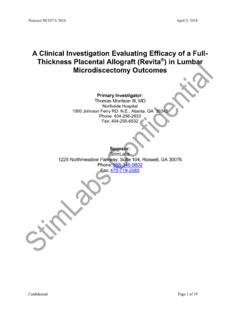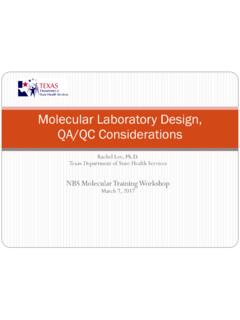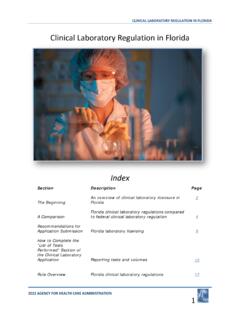Transcription of Clinical Laboratory Improvement Amendments (CLIA)
1 Clinical Laboratory Improvement Amendments ( clia )Verification of Performance SpecificationsNOTE: Congress passed the Clinical Laboratory Improvement Amendments ( clia ) in 1988 establishing authority to promulgate standards for certain Laboratory testing to ensure the accuracy, reliability and timeliness of test results regardless of where or by whom the test was performed. The clia requirements are based on the complexity of the test and the type of Laboratory where the testing is performed. While every effort has been made to ensure the accuracy of this restatement, this brochure is not a legal document. The official clia program requirements are contained in the relevant law, regulations and rulings.
2 Please note that state, local, and accreditation requirements may be more is verification of performance specifications required?This is required prior to reporting patient test results whenever an unmodified, FDA-cleared or approved non-waived test system ( , moderate and high complexity) is introduced into the Laboratory *. This includes the following: A test system that is introduced into the laboratoryfor the first time to measure an analyte that thelaboratory has not previously measured; A test system introduced for the first time intothe Laboratory for a test that the Laboratory currently performs on an alternativetest system ( , instrument A has been used to perform cholesterol testing, nowinstrument B will be used); An analyte added to a test system that can measure multiple analytes, which thelaboratory has been using for patient testing, but has not previously reported patientresults for this particular analyte.
3 And When multiple instruments (including the same make and model, , point-of-care instruments) are used to perform the same test, the Laboratory must verifyperformance specifications for each : This document does not address modified FDA-cleared or approved test systems, test systems not subject to FDA clearance or approval (including methods developed in-house and standardized methods such as textbook procedures), or test systems in which performance specifications are not provided by the manufacturer. Additionally, laboratories should be cognizant of the effect that relocation of a test system, or relocation of the Laboratory , has on the performance of the test system, while ensuring that its verification of performance specifications for each test system have not been affected.
4 * Exception: Verification of performance specifications is not required for unmodified,FDA-cleared or approved test systems that were in-use in the Laboratory prior toApril 24, is responsible for ensuring verification of performance specifications is completed?The Technical Consultant/Technical Supervisor or Laboratory Director are responsible for ensuring the procedure used for verifying the performance specifications is adequate, as well as evaluating the results generated during the verification process. The test system manufacturer may also assist by providing a verification procedure and appropriate samples for the evaluation. However, the verification procedure must be approved by the Laboratory Director and the Laboratory staff must participate in the verification process.
5 The manufacturer may assist the Laboratory with performing this activity; however, the Laboratory must perform the verification of the test system performance specifications. The Laboratory Director is required to ensure that verification procedures are adequate to determine the accuracy, precision, and other pertinent performance characteristics of the Technical Consultant/Technical Supervisor is responsible for verification of the test procedures performed and the establishment of the Laboratory s test performance characteristics, including the precision and accuracy of each test and test system. What is included in verification of performance specification of my test system?
6 You must compare the performance of the test system in your Laboratory with those specifications established by the manufacturer. This includes the following performance characteristics: Accuracy Precision Reportable range Reference intervals/range (normal values) for the Laboratory s patient population4 AccuracyAre your test results correct?The Laboratory needs to compare the accuracy of the test results it obtains when using a test system with the manufacturer s accuracy claims. This can be done by testing commercially available calibrators/calibration or quality control (QC) materials with known values, proficiency testing materials that have established values, or previously tested patient specimens with established values.
7 This can also be done by comparing results of tests performed by the Laboratory against the results of a reference method, or comparing split sample results with results obtained from another method which has already been shown to provide accurate results. If test results for these samples fall within the manufacturer s stated acceptable limits, accuracy is qualitative methods, the Laboratory must verify that a method will identify the presence/absence of the you obtain the same test result time after time?The Laboratory is responsible for verifying that it can repeatedly test the same samples under different conditions and get the same or comparable results (reproducible), regardless of which member of the Laboratory s testing personnel performs the test (operator variance).
8 For example, consider testing samples with known values ( previously reported patient samples, QC materials, or calibration materials) in different runs on different days, as well as multiple times within the same run. Several of the Laboratory s testing personnel should participate in this evaluation to help determine overall Laboratory variance. Exception: For fully automated test systems that are not operator dependent, operator variance should not affect the test s precision and may not need to be evaluated by more than one RangeHow can you be sure very high and very low test results are accurate?To verify the manufacturer s established reportable range for the test, choose samples ( previously reported patient or proficiency testing samples with abnormal high and abnormal low values, QC materials, or calibration materials) with known values at the highest and lowest levels the manufacturer claims accurate results can be produced by the test system.
9 The Laboratory may only report patient test results that fall within the verified levels. The Laboratory Director and/or the Technical consultant/Technical supervisor will need to decide how the Laboratory will report results that are greater than the highest verified level or less than the lowest verified Intervals/Range (Normal Values)Do the reference ranges provided by the test system s manufacturer fit your patient population? The Laboratory may use the manufacturer s reference range, as long as it is appropriate for the Laboratory s patient population ( , a normal range that reflects the type of specimen and demographic variables such as age and sex, as applicable).
10 If the manufacturer has not provided reference ranges appropriate for the Laboratory s patient population, the Laboratory may use published reference range(s). The Laboratory must evaluate an appropriate number of specimens to verify the manufacturer s claims for normal values or, as applicable, the published reference many samples do I need to test?Depending on the test system and the Laboratory s testing volume, the actual number of specimens needed for each part of the verification study may vary. The Laboratory Director and Technical Consultant/Technical Supervisor are responsible for determining the appropriate number of the Laboratory Director has reviewed and approved the results of the verification studies, the Laboratory may begin using the test system for routine testing and reporting patient test results.












